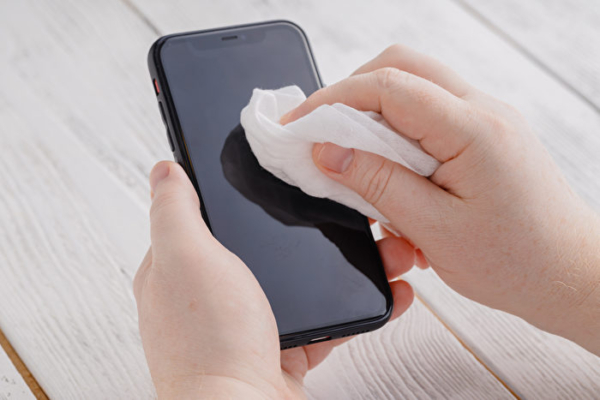In modern times, people often use smartphones, carrying them everywhere and using them constantly, which makes them prone to bacterial contamination. Previous studies have shown that there are more bacteria on smartphones than on toilet seats. Experts have shared methods on how to clean phones without causing damage to the devices themselves.
Researcher Meena Jha from the Central Queensland University in Australia pointed out in an article on The Conversation website that smartphones can harbor various potentially harmful bacteria. While not all bacteria may lead to diseases, the possibility of transmission exists. For example, people often use their phones in restrooms, then place them close to their mouths, touch them while eating, and pass them around in crowded places like meeting rooms, cafes, gatherings, and classrooms.
Unlike hands that can be washed regularly, phones are rarely properly cleaned and sometimes not at all. It is important to clean your phone without causing any damage during the cleaning process. Using the wrong cleaning agents or tools can strip the phone’s protective coating, reduce its waterproof seal, and even affect its touch sensitivity.
Jha mentioned that using household cleaners or hand sanitizers to quickly wipe down a phone may seem like a good idea for maintaining cleanliness. However, many of these products can gradually damage the surface and internal components of the phone.
For instance, both Apple and Samsung advise against using bleach, hydrogen peroxide, vinegar, aerosol sprays, glass cleaners, or alcohol wipes with a concentration exceeding 70% on the phones they produce.
Most smartphones have an oleophobic coating, a thin film that helps prevent fingerprints and stains. Agressive chemicals like alcohol, acetone, or ammonia-based cleaners can erode this coating, making the screen more prone to stains and reducing touch sensitivity.
Vinegar, a common DIY disinfectant, is highly acidic and can corrode aluminum or plastic edges. While bleach and hydrogen peroxide are effective disinfectants, they can be too corrosive for the delicate materials used in consumer electronics. Alcohol-heavy wipes may dry out plastic, and continued use could make them brittle.
In short, if a cleaning agent is strong enough to sanitize your kitchen countertop, it may be too harsh for your phone.
As for how to clean a smartphone, Jha suggested that it is both simple and inexpensive. By following the manufacturer’s guidelines, you can clean your phone effectively. When cleaning your phone, remember to remove all protective cases or accessories.
Most manufacturers recommend using 70% isopropyl alcohol wipes (not exceeding 70% concentration), soft microfiber cloths, and antistatic brushes made of nylon, horsehair, or goat hair to clean sensitive areas like speaker grilles and charging ports.
During the COVID-19 pandemic, Apple updated its cleaning guidelines to permit the use of Clorox disinfecting wipes and 70% isopropyl alcohol on iPhones; however, gentle actions are recommended to avoid damaging the screen coating or allowing moisture to seep into the device.
Samsung also has similar cleaning guidelines, recommending the use of a microfiber cloth dipped in a 70% alcohol solution to wipe the phone while avoiding direct contact with ports and openings.
Jha warned against directly spraying cleaning solutions on the phone, as moisture could penetrate ports and internal components, leading to short circuits or corrosion. Submerging a phone in any cleaning solution poses a risk, even for waterproof phones, as the sealing materials degrade over time.
Additionally, avoid using tissues, paper towels, or rough fabric that may scratch the screen or leave lint in openings. Overcleaning should also be avoided, as excessive wiping or scrubbing can wear down the protective coating, making the phone more susceptible to fingerprints, stains, and long-term damage.
Regarding how often a phone should be cleaned, Jha suggested that there is no strict rule, but under normal use, a weekly wipe down is reasonable. If you frequently bring your phone to high-risk environments like public transportation, hospitals, gyms, or bathrooms, it’s best to clean it more often.
In conclusion, improper handling can gradually damage your phone. However, correct procedures are simple, cost-effective, and do not require much time.

